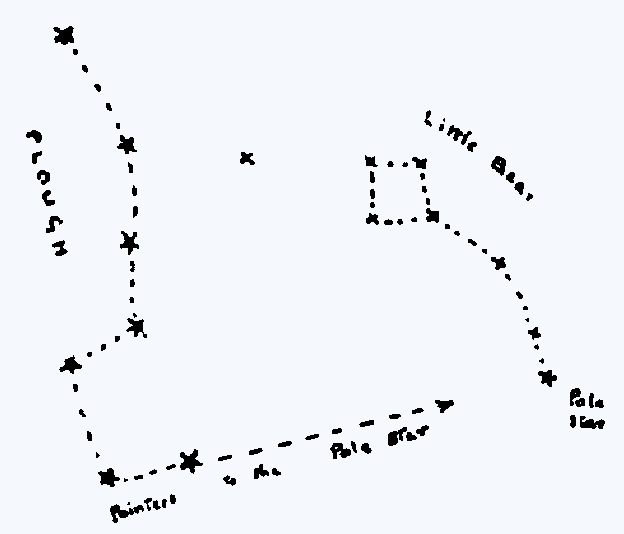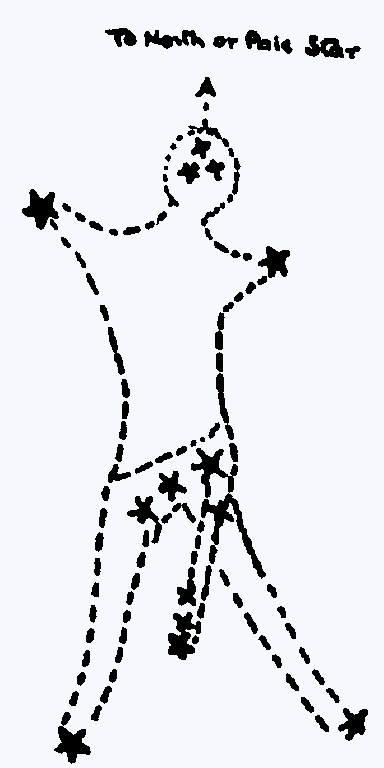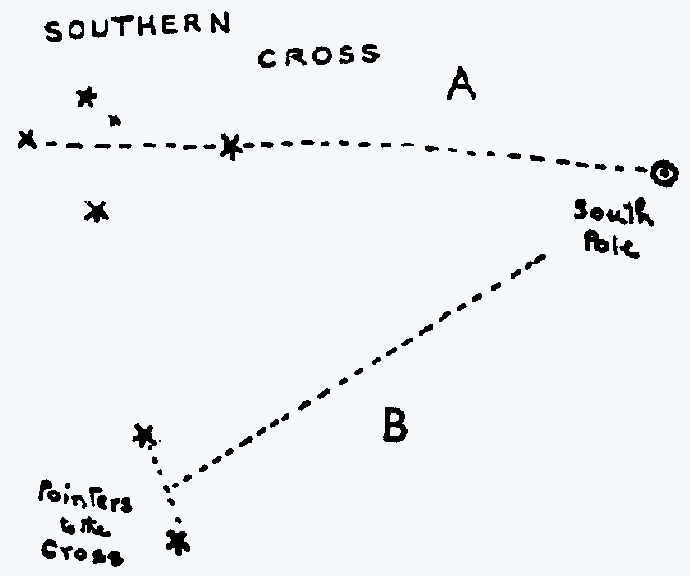Finding the North without a Compass
Besides the "Magnetic North" which you find with your compass, there is the other north of the North Pole at the top of the earth. This is the real north and for that reason is named "True North".
North by the Sun
If you have no compass to show you "Magnetic North", the sun will tell you by day where "True North" is, and from that you can figure out the other directions.

When the sun is out, a watch will help you find your directions.
At six o'clock in the morning Greenwich Mean Time the sun is east. At nine it is south-east. At noon it is south. At three o'clock in the afternoon it is south-west, and at six o'clock it is west. In winter it will have set before six o'clock, but will not have reached west when it is set. This applies roughly in the Northern Hemisphere. (In the Southern Hemisphere, at six o'clock the sun is east, at nine north-east, at noon north, at three north-west, at six west.)
The Phoenicians who sailed round Africa in ancient times noticed that when they started the sun rose on their left-hand side-they were going south. Then they reported that they came to a strange country where the sun rose in the wrong quarter, namely on their right hand. The truth was that they had gone round the Cape of Good Hope, and were headed north again, up the east side of Africa.
To find the south at any time of day by the sun, hold your watch flat, face upwards, so that the sun shines on it. Turn it round till the hour hand points at the sun: allow for Summer Time if it is in operation. Without moving the watch, lay a pencil or stick across the face of the watch so that it rests on the centre of the dial and points out half-way between the figure XII and the hour hand. The direction in which it points is south. This applies only in the Northern Hemisphere. (In the Southern Hemisphere turn the XII, instead of the hand, to the sun, and south will then lie between the two as before.)
North by the Stars
Various groups of stars have been given names because they seemed to make some kind of picture outline of men and animals.

Two stars of the Plough or Big Dipper point toward the Pole Star.
The Plough or the Big Dipper is an easy one to find. It is shaped something like a plough or dipper. It is the most useful star group for a Scout to know, because in the northern part of the world it shows him where north is. The Plough is also called the Great Bear. The stars in the curve make its tail. It is the only bear I know that wears a long tail.
Pole Star-The two stars in the Plough called the Pointers tell you where the North or Pole Star is. It is the last star in the tail of the Little Bear. All stars and constellations move round the sky during the night, but the Pole Star remains fixed in the north.
Orion-Another group of stars, or constellation, represents a man wearing a sword and belt, and is named Orion. It is easily recognized by three stars in a line, the "belt", and three smaller stars in another line, close by, the "sword". Two stars to right and left below the sword are Orion's feet, two more above the belt are his shoulders, and a group of three small stars between them make his head.
The Zulus call Orion's belt and sword the "Ingolubu", or three pigs pursued by three dogs. The Masai tribe in East Africa say that the three stars in Orion's belt are three bachelors being followed by three old maids.
You see, scouts all know Orion, though under different names.

A line through Orion will eventually reach the Pole or North Star.
The great point about Orion is that by him you can always tell which way the North or Pole Star lies, and you can see Orion whether you are in the south or the north part of the world.
If you draw a line, by holding up your staff against the sky, from the centre star of Orion's belt through the centre of his head, and carry that line on through two big stars till it comes to a third, that third star is the North or Pole Star.

In the Southern Hemisphere, the Southern Cross tells the direction
Southern Cross-On the south side of the world, in South Africa, South America, New Zealand and Australia, the Plough is not visible. Here the Southern Cross points toward south (see diagram). If you carry your eye along the same direction, A, as the long stem of the Cross for a distance of about three times its length, the point you hit will be about due south. Or if you imagine a line between the two Pointers and another imaginary line, B, standing upright on this first line and continued until it cuts the line A in continuation of the stem of the Cross, the point where A and B cut each other will be the south.
Author
Lord Baden-Powell of Gilwell (Chief Scout, London, UK)
Date of Creation
1908
Learn A Continuation:
to the next page: Weather Wisdom
Back in The Past:
to the previous page: Using a Compass
Мнение автора и других создателей данного материала
может не совпадать с официальной позицией администрации сайта.
Borishof-havalpro.ru
При использовании материалов сайта обратная ссылка на GomelScouts.com обязательна.